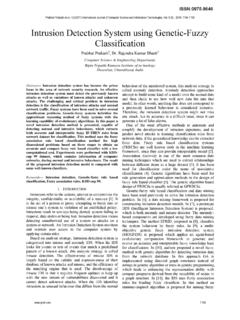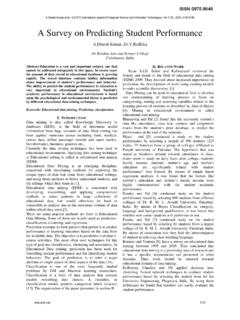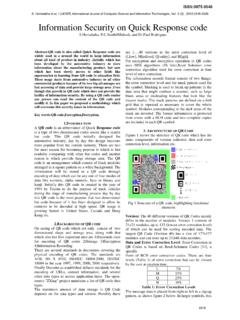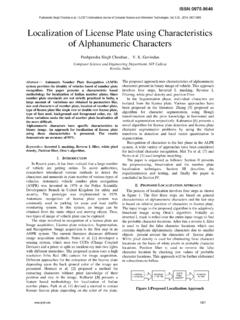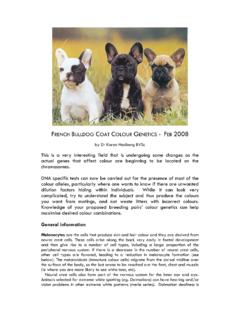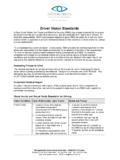Transcription of Vision Based User Authentication System for Industrial ...
1 Piyush Anjankar et al, / (IJCSIT) International Journal of Computer Science and Information Technologies, Vol. 6 (4) , 2015, 3749-3752. Vision Based user Authentication System for Industrial Application Anjankar #1, Borkarr*2. #1. Scholar, Department of CSE, Nagpur Institute of Technology, Nagpur, RTM Nagpur University, India #2. Asst. Professor, Department of CSE, Nagpur Institute of Technology, Nagpur, RTM Nagpur University, India. Abstract In this paper we are presenting the scheme of studies only permit one degree of liberty, which is not better Authentication System using Vision Based approach to appropriate for the estimation of head incline positions handle various activity in Industrial application environment. [4]. In latest years, face recognition has fascinated much While going through various scholar's research work and responsiveness and its study has quickly extended by not article, the human face plays an important role in our social interaction and conveying individual identity.
2 Using the only engineers but also neuroscientists, since it has many human face as a key to security, face recognition technology prospective applications in computer hallucination has received significant attention in the past several years due communication and programmed or automatic access to its potential for a wide variety of applications . In this paper control System . Particularly, face detection is an method for better Vision Based Authentication is included with essential part of face recognition as the first stage of lowest cost of implementation using the OpenCV haar cascade involuntary face , face detection is Classifiers. not straight forward mechanism for detection, for the reason that it has lots of variations of image presence, Keywords Artificial Neural Networks (ANN), face such as pose disparity (front, non-front), recognition, OpenCV, haar classifiers, AdaBoost, Integral Image. imageOrientation, enlightening condition and facial expression and appearance. [5].
3 A lot of pioneering methods have been recommended to I. INTRODUCTION resolve each disparity. For example, the template- Face recognition is done apparently done by humans. matching approach are used for face localization and However, designing the computer algorithm to do the same detection by calculating the correlation of an input image work is very challenging [1]. Human face recognition is one to a standard face pattern. The feature invariant methods are of the dynamic area of research and it is a initial step to a used for feature detection of eyes, mouth, ears, nose, etc. [6]. varied range of practical applications which comprises [7].Face recognition is used for two principal works [8]: image processing, pattern recognition, personal identity 1. Verification (one-to-one matching): When verification, video-surveillance, advanced human and offered through a face image of an indefinite individual computer interaction, computer Vision etc.[2]. Most of along with a right of identity, determining whether the these applications are using Artificial Neural Networks indefinite individual is who he/she privileges to be as (ANN) classifiers methods together with suitable feature he/she claimed.
4 Extraction for recognition of human faces. Face detection is 2. Identification (one-to-many matching): Given essential first-step in face recognition systems, with the an image of an unidentified individual, decisive that determination person's uniqueness by matching (possibly after Of localizing and extracting the face region from the encoding) that image with a databank or database of relative background [3].The human face is an active images of (possibly encoded) images of identified dynamic object, has a great high degree of variability in its individuals. appearance, which creates face detection a challenging task In the rotation invariant centred face detection in computer Vision . Gesture recognition is an area in assessment interconnected study we found that, for computer science and language technology with the identifying the face in an image general technique to objective of understanding human gestures via accurate create template- Based face detector rotation in variant algorithms.
5 Gestures can initiate from any bodily centred neural network-algorithm in gray-scale images is gesture or state however usually initiate from the face used. The System offered in Rowley et al used two or hand. A principal objective of gesture recognition different network System for face detection viz. router exploration is to build a System which know how to network for manipulating the head tilt angle and detector recognize unambiguous human gestures and use them to network, which derotated the image given by router carry facts or for device control and work promptly. network and identify the face within the image. To We emphasis on face detection, head position eliminate any further irregularities in the detection of face approximation ,various scholars' works which are the heuristic approach is used. This System is able detect restricted to identifying straight, frontal faces, many about 70% of two large test set. The main shortcoming of 3749. Piyush Anjankar et al, / (IJCSIT) International Journal of Computer Science and Information Technologies, Vol.
6 6 (4) , 2015, 3749-3752. this System is the necessity of very large database for own Weaknesses and strengths which we are already template matching, which comprise of both negative and discuss in section-I. Most of the algorithms that we are positive image. The positive image are those images which discuss are very expensive in terms of computational comprise thhe face, and negative are the one who does not processing. An image is solitary a group of color and/or comprise any faces [9]. light intensity values, which can benefitted for computer In the head angle approximation associated programmer to use its various aspects for enhancing and exploration, scholar's presented a vigorous approach to updating it. Image is a composition of pixels and analysing evaluation of the 3D pose of human heads by means of a these pixel are very time consuming and difficult to single image. Their process only makes use of the accomplish because of the wide variations of shape and statistics about the skin and hair region of the heads.
7 Pigmentation within a human face. Chen et al gives the robustness and the consistency of We are using Haar classifiers for face gesture recognition, facial feature tracking. This System uses two global devised by Viola and Jones. Viola and Jones presented a evidence as area and centre of skin and hair region. This method to precisely and rapidly detect faces with in an System uses a perceptually unchanging colour space to image within an image. This algorithms and visions to idea define the colour information of images. It uses two to develop a framework for robust and extremely rapid global tables to describe the skin colour likeness and the object detection. Viola and Jones devised an algorithm, hair colour likeness of all visible colours. These tables are called Haar Classifiers, to rapidly detect any object, named as SCDM (Skin Colour Distribution Model) and including human faces, using AdaBoost classifier cascades HCDM (Hair Colour Distribution Model). It first convert that are Based on Haar-like features and not pixels [11].
8 The colour information of each pixel (R,G,B) to the chromaticity in perceptually unchanging colour space A. Haar Classifiers (uf,vf) and the luminance (y): (R, G, B) (y,uf,vf) ..(i). The skin region and the hair region in an image are then removed by estimating the skin color likeness and the hair color likeness for each pixel with SCDM and HCDM. SCSM (p) =SCDM (uf (p)), vf (p)) ..(ii). HCSM (p) =HCDM(y (p), uf (p), vf (p)) ..(iii). Where SCSM and HCSM are the skin color likeness and the hair color likeness of pixel p. y(p), uf(p) and vf(p) are the luminance and the chromaticity of pixel p. The face detection is carried out by comparing every rectangle region of SCSM and HCSM with several prebuilt head shape model. After finding the skin and hair colour likeness region, this System find the area, center and axis of skin/. hair region and then center for face and hair region. This System also calculate the depth in three dimension in X-axis, Y-axis and Z-axis [10]. Fig 1:Common haar features This following section of this paper covers more as, Section-II covers the detail concepts pf Haar classifiers The core basis for Haar classifier object detection is the Based cascade Feature , Section-III covers the implemented Haar-like features.
9 These features, rather than using the System with some outputs of System , Section-IV covers the intensity values of a pixel, use the change in contrast values conclusion and future work in this System and final Section- between adjacent rectangular groups of contrast V covers references that are usefull while going for this variances between the pixel groups are used to determine research work development. relative light and dark areas. Two or three adjacent groups with a relative contrast variance form a Haar-like feature II. Haar Classifiers Based cascade features which are shown in Fig-1. The human face postures even more difficult to recognize than other objects since the human face is an B. Integral Image active and dynamic object that arises in a several forms and The simple rectangular features of an image are color. But however, facial detection and stalking offers calculated using an intermediate representation of an image, many benefits and profits for face recognition.
10 Facial called the integral image. Integral image allows for precise recognition is not possible if the face is not desolate or and very rapid feature evaluation. Motivated in part by the removed from the background. Human Computer work of Papageorgiou et al. Viola and Jones, detection Interaction (HCI) field could significantly enriched by System does not work directly with image intensities [12], using gesture recognition particularly face recognition, butt instead of these use a set of features which are which naturally require face and facial feature detection and significant of Haar Basis functions. In order to work out tracking mechanism Although various algorithms and with these features very rapidly at many scales we introduce techniques are exist to perform face detection, each has its the integral image representation for images. The integral 3750. Piyush Anjankar et al, / (IJCSIT) International Journal of Computer Science and Information Technologies, Vol. 6 (4) , 2015, 3749-3752.


